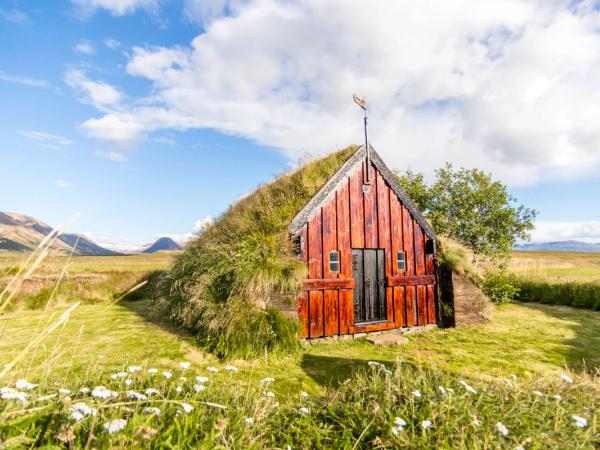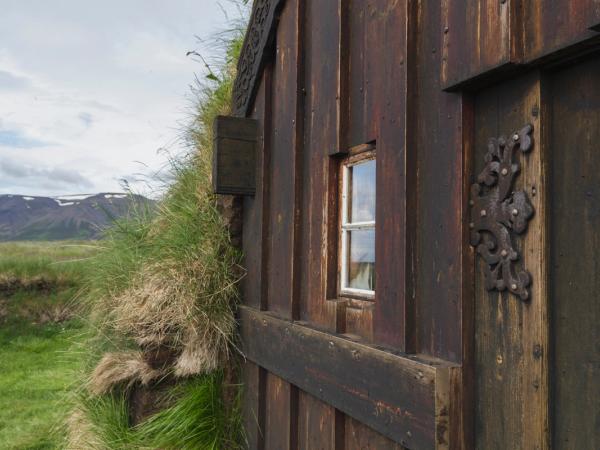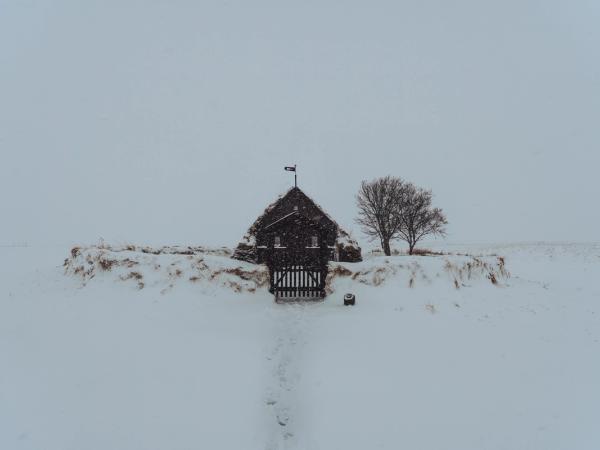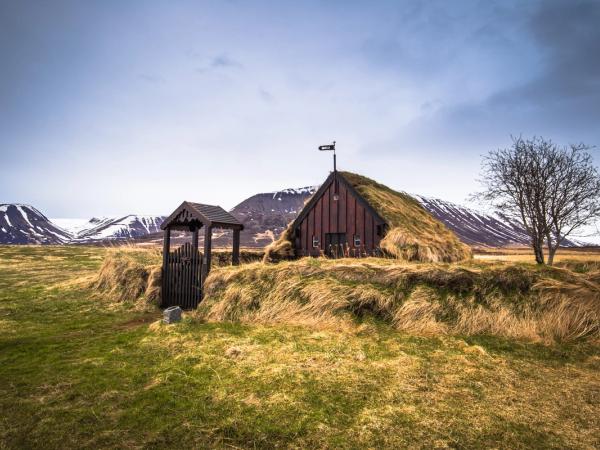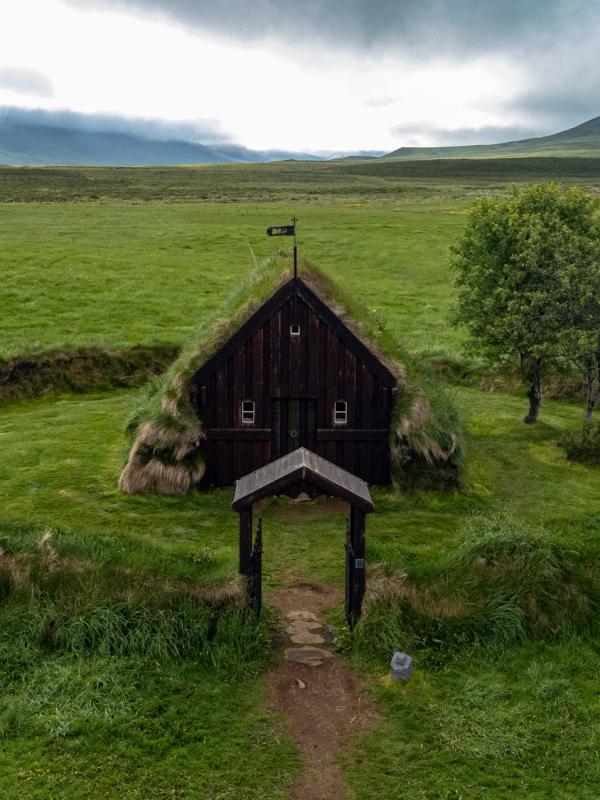
Grafarkirkja: Iceland's Oldest Turf Church
Iceland has many amazing sights, from waterfalls to geothermal areas. But in the northern region sits a small structure that tells a deeper story about Icelandic history and architecture. Grafarkirkja isn't on most tourist maps, but this small turf church offers a glimpse into Iceland's past that's worth finding.
Key Takeaways
- Grafarkirkja is Iceland's oldest turf church, with parts dating back to the 17th century and mentions from as early as 1240
- Located in Höfðaströnd, North Iceland, it's easy to reach from nearby towns like Hofsós
- The church has unique circular turf walls and beautiful baroque wood carvings
- Though closed to the public for preservation, you can still view it from the outside
- The area around it has plenty to see, from museums to hot springs, making the trip worthwhile
What is Grafarkirkja? Iceland's Oldest Turf Church
Grafarkirkja (Church of Grafar) is Iceland's oldest turf church, a building style that shows how Icelanders adapted to their harsh environment. This small structure stands as a piece of Iceland's architectural and religious heritage.
A Rich History Dating Back to the 13th Century
Grafarkirkja's history runs deep. The first mention of a church at this site appears in the Sturlunga Saga from around 1240, during one of Iceland's most turbulent periods. The current structure includes parts from the 17th century, likely built under Gísli Þorláksson.
The church's story includes a fall and a rise. In 1765, the Danish monarchy ordered it deconsecrated, and it became a storeroom. The church might have been lost if not for the National Museum of Iceland, which bought it in 1939. After careful restoration, Grafarkirkja was reconsecrated in 1953, with more repairs done in 2011.
The church is also linked to important cultural figures. Hallgrímur Pétursson, Iceland's famous hymn writer and poet, was likely born at the Gröf farm. His legacy lives on in Reykjavík's Hallgrímskirkja, named after him. Another key figure, Ragnheiður Jónsdóttir, held mass at Grafarkirkja every third holy day until she died in 1715, showing the church's role in local religious life.
Architectural Features That Make It Unique
Grafarkirkja shows traditional Icelandic building methods. Using timber and turf, local builders created a structure that could handle Iceland's harsh weather while using materials available in the treeless landscape.
The church is just 6.25 meters long and 3.20 meters wide, with seats for about 30 people. What makes it special is its circular turf wall around both the church and graveyard, an old design rarely seen in buildings today. This design protected the church from wind and created a clear line between sacred and everyday space.
Inside, the wooden roof has baroque-style carvings by Guðmundur Guðmundsson, a 17th-century wood carver from Bjarnastaðahlíð. These details add artistic value to a simple structure. The altarpiece, a reprint from 1680, shows religious scenes including the Crucifixion and Last Supper.
Current Status and Preservation Efforts
Currently, Grafarkirkja is closed to the public. This isn't to keep people away but to protect this fragile historical site. Turf buildings require ongoing maintenance because their organic materials degrade over time. The National Museum of Iceland manages Grafarkirkja as part of its Historic Building Collection, working to keep it standing for future generations.
Even though you can't go inside, you can still see the church from outside, taking in its unique shape against the North Iceland landscape. The circular turf wall and the church's modest form create a picture that captures Iceland's architectural heritage.
Where Is Grafarkirkja Located & How to Get There
Grafarkirkja is in Höfðaströnd, a coastal area in North Iceland's Skagafjörður region. It's part of the Gröf farm complex on the Skagi peninsula, a place of rugged beauty and historical importance.
You'll find the church about 4 kilometers south of Hofsós village, just off road 76. Its somewhat remote location adds to its charm, but it also means you need to plan your visit.
Transportation Options from Nearby Cities
If you're coming from Reykjavík, plan for a drive of about 325 kilometers (202 miles), which takes roughly 3.5-4 hours without stops. Most people include Grafarkirkja in a bigger North Iceland trip rather than making it a day trip from the capital.
For those staying in the north, the church is easy to reach:
- From Akureyri: About 128 kilometers (79.5 miles), a 1.5-hour drive
- From Sauðárkrókur: About 30 kilometers (19 miles), a 25-minute drive
- From Hofsós: Just 4.5 kilometers (2.8 miles), a quick 5-minute drive
Public transportation in this area is limited, so renting a car gives you the most flexibility. The roads to Grafarkirkja are good, though winter can make driving hard from November through April. Always check road.is for current conditions before leaving, especially during winter.
Things to Do Near Grafarkirkja
Since Grafarkirkja itself takes only a short visit (as you can't enter the building), it’s a good idea to combine it with some of the many other attractions present in the area.
Exploring Hofsós Village (4km)
The small village of Hofsós is just a few minutes' drive from Grafarkirkja and has several interesting stops:
- Hofsós Swimming Pool is one of Iceland's most beautiful pools. This modern infinity pool has excellent views over the Skagafjörður fjord. The geothermal waters provide a nice soak, especially after a day of exploring. Entry (for adults) costs around $10, and the pool is open year-round, though opening hours change with the seasons.
- The Icelandic Emigration Center shows the 19th-century emigration of Icelanders to North America. Housed in historic buildings, the museum tells the stories of families who left Iceland for new opportunities. Open daily in summer, from June 1st to August 1st, from 10 AM to 6 PM.
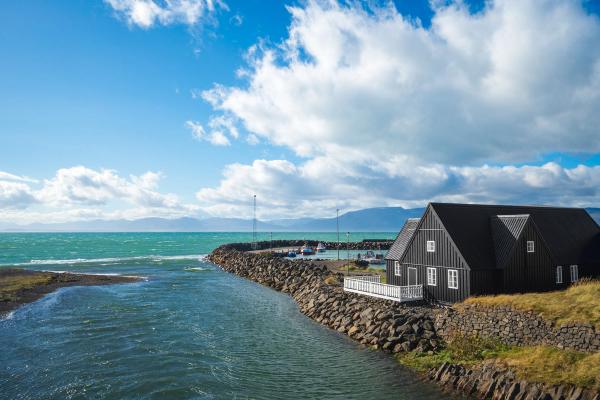
Historical Sites Within a Short Drive
Several important historical sites near Grafarkirkja help put the church in context:
Hólar Cathedral (23 km away)
Hólar Cathedral was a major religious center in Iceland's history. Built in 1763, this stone cathedral has links to Grafarkirkja through bishops like Gísli Þorláksson. The simple yet elegant interior includes historical artifacts and beautiful stone work.
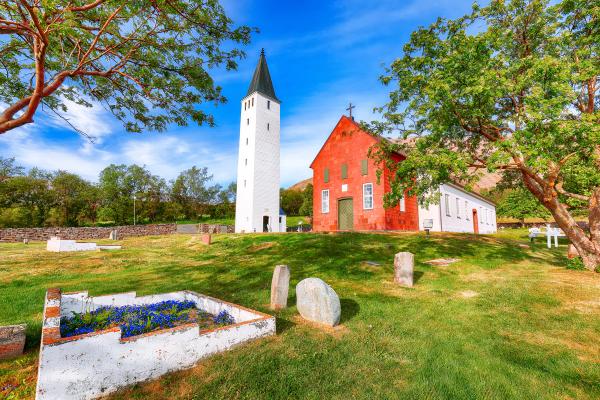
Víðimýrarkirkja (36 km away)
Víðimýrarkirkja offers a good comparison to Grafarkirkja. Built in 1834, it's considered one of Iceland's finest turf churches. Since both churches use turf construction, Víðimýrarkirkja's more recent origins and excellent condition show how these structures changed over time.
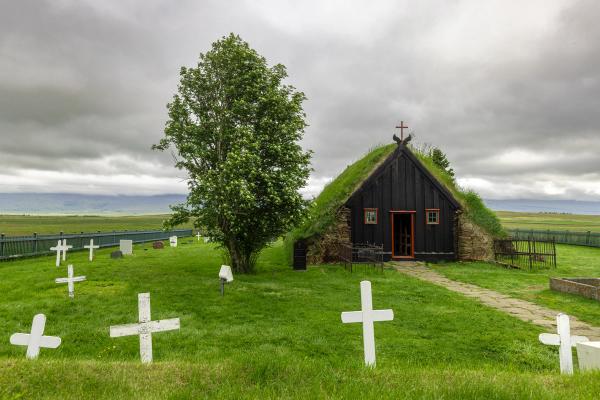
Glaumbær Farm and Museum (33km away)
The Glaumbær Farm and Museum shows a preserved 19th-century turf farm. As part of the National Museum of Iceland's collection, it gives a glimpse into rural Icelandic life with displays of household items and historical photos. The site includes Áskaffi café, where you can try traditional Icelandic pancakes.
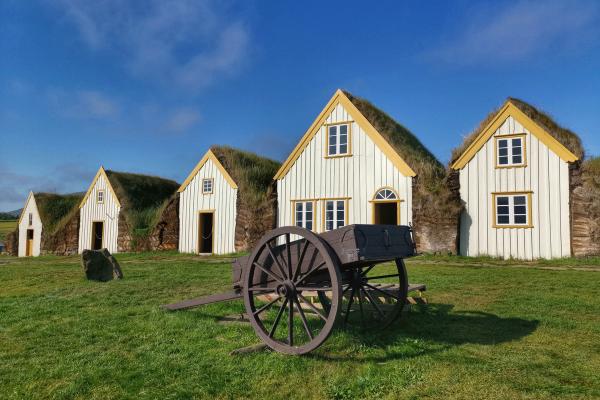
Natural Wonders and Outdoor Adventures
North Iceland's landscape offers plenty of natural beauty to explore:
- Horseback Riding provides a traditional way to see the Icelandic countryside. Farms like Lýtingsstaðir (about 65 km away) offer rides ranging from one-hour tours to full-day adventures, all featuring the Icelandic horse with its smooth tölt gait.
- Drangey Island Boat Tours from Sauðárkrókur harbor take you to a dramatic island rising from Skagafjörður fjord. From May to August, the island hosts thousands of seabirds, including puffins, guillemots, and kittiwakes. Tours cost $95-145, depending on whether you want to hike the island or just sail around it.
- The Tröllaskagi Peninsula Scenic Drive along Route 76 (Siglufjarðarvegur) offers one of Iceland's most beautiful road trips. The route connects Hofsós to Siglufjörður, with fjord views, mountain passes, and small fishing villages.
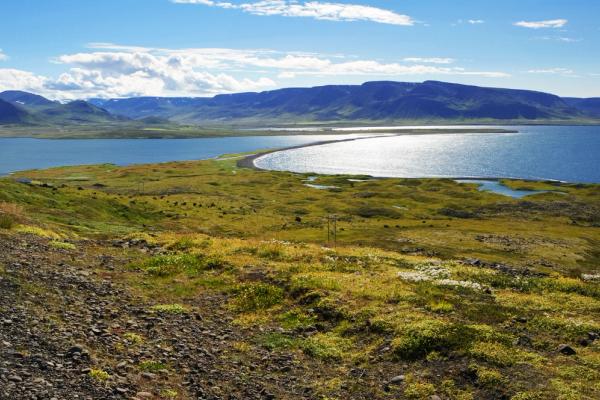
Cultural Experiences
Cultural experiences include the 1238: The Battle of Iceland museum in Sauðárkrókur. This immersive museum uses virtual reality to explore the Sturlung era, the same historical period when Grafarkirkja was first mentioned in sagas. Entry costs about $27, and it's open daily. It’s just a 25-minute drive from the church.
Best Time to Visit Grafarkirkja
Each season offers a different experience when visiting Grafarkirkja:
Summer (June-August)
Summer has the best conditions. Extended daylight hours (nearly 24 hours in June) mean plenty of time to explore, and the milder temperatures make the trip more comfortable. This is also when most nearby attractions are open with their extended schedule. The drawback? This is peak tourist season, so popular sites may be crowded.
Fall (September-October)
Fall has fewer crowds and beautiful autumn colors across the landscape. Temperatures remain relatively mild, though rainfall increases. Some attractions begin to reduce their hours, so check in advance.
Winter (November-March)
Winter turns North Iceland into a snow-covered landscape. Grafarkirkja's turf structure looks striking against the snow. This season also brings the chance to see the Northern Lights. However, daylight is limited (as little as 4-5 hours in December), and road conditions can be challenging.
Spring (April-May)
Spring sees nature waking up, with wildflowers starting to bloom. The weather can change quickly, with a mix of rain, sun, and occasional snow, but crowds remain small.
Weather and Accessibility Tips
North Iceland has more extreme weather than the south, so come prepared. Summer temperatures typically range from 10-15°C (50-59°F), while winter can drop to -10°C (14°F) or lower.
Road 76, which passes near Grafarkirkja, is generally well-maintained and open year-round. However, winter storms can temporarily close roads or make driving difficult. Always check road.is before heading out in the winter months.
If visiting in summer, the best lighting for photos comes in the evening when the low-angle sunlight creates a golden glow on the turf. In winter, plan your visit during the limited daylight hours, ideally around midday when the sun is at its highest.
What to Bring and How to Prepare
When visiting Grafarkirkja and the surrounding area, pack these essentials:
- Sturdy, waterproof hiking boots - The ground around the church can be muddy, especially after rain
- Layered clothing - Weather in Iceland can change rapidly, even in summer
- Waterproof outer layer - Rain can appear without warning
- Camera - Preferably with a wide-angle lens to capture the church and its landscape setting
- Binoculars - Helpful for birdwatching along the coast or spotting details on distant mountains
- Map or GPS - Cell coverage can be spotty in remote areas
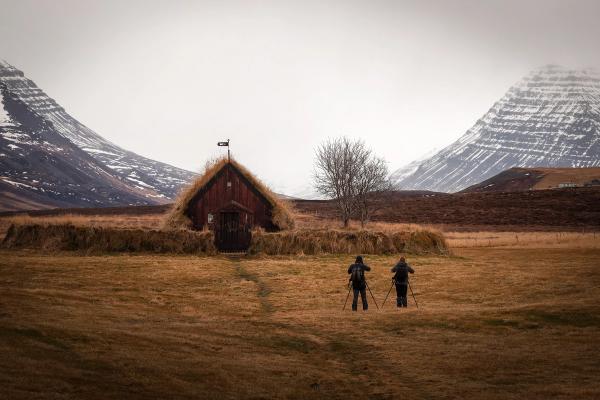
Respecting the Site and Cultural Etiquette
While Grafarkirkja welcomes visitors, remember these important points:
- Don't attempt to enter the church - It's closed to protect the fragile structure
- Avoid touching or climbing on the turf walls - These can be easily damaged
- Stay on established paths - This helps prevent erosion around the site
- Leave no trace - Take all trash with you when departing
- Speak quietly - Though not active for services, this remains a church and place of respect
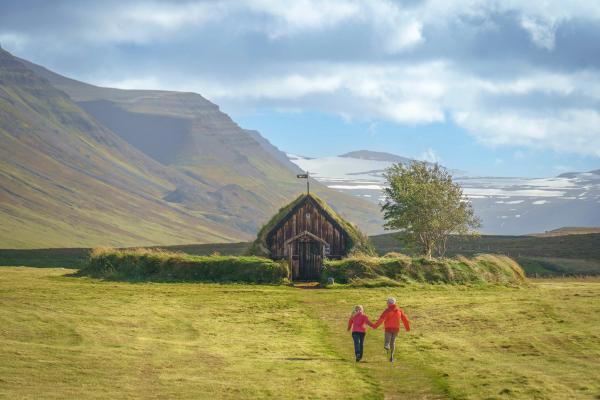
Conclusion
Grafarkirkja may be small, but it holds great historical and cultural value. This humble turf church offers a window into Iceland's past that few other structures can match. While you can't go inside, simply standing before this centuries-old building connects you to generations of Icelanders who worshipped, celebrated, and mourned within its walls.

